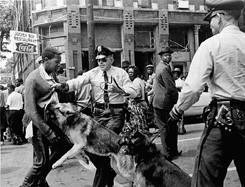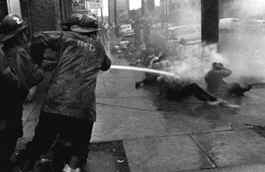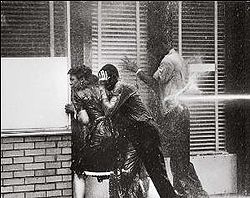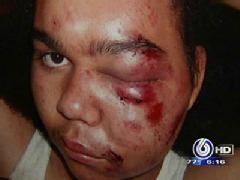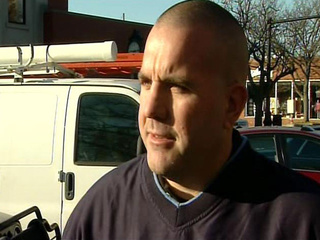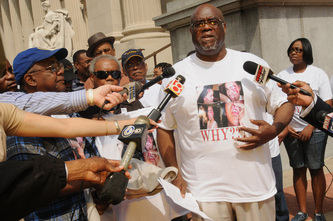Has Martin Luther King's Dream Come True, Today?
Police Brutality and Misconduct
"There are those who are asking the devotees of civil rights, "When will you be satisfied?" We can never be satisfied as long as the Negro is the victim of the unspeakable horrors of police brutality."
Police brutality and misconduct have been present throughout history. From the days of slavery, through the Civil Right Movement era, to the Rodney King beating which led to the L.A. riots and up to the present day, with the most recent beating of Brandon Johnson by a police officer, it still exists in the year 2010. Police brutality and misconduct are merely the major contemporary forms of State-sponsored racist violence. Police brutality is described as "instances of serious physical or psychological harm to civilians." Contemporary police brutality consists of deadly force, the use of excessive force, and it includes unjustified shooting, fatal choking, and physical assault by law enforcement officers. Police misconduct is inclusive of planting evidence, making untrue statements, filing untrue written reports, condoning untrue statements and/or reports by keeping silent, threatening suspects, arrestees, and witnesses, engaging in illegal activities, and committing perjury.
Racist violence reached its highest point after Emancipation. From 1882-1910, lynching was the major form of violence used against African Americans. Between 1882 and 1930 approximately 3,000 Blacks (mostly male) were lynched. After 1930, extralegal race riots and legal executions replaced lynching as means of social control. All white or predominately white juries and government officials merely extended societal racial discrimination to executions.
In contemporary America, police brutality is the preferred form of social control.
Police administrators have ignored or been lax in using internal department policies and procedures to punish officers who have displayed a pattern of brutality and/or misconduct. Internal department policies are often weak and internal investigations are generally conducted poorly.
Finally, criminal prosecutions for police brutality or misconduct rarely occur because few state prosecutors are willing to aggressively pursue abusive officers.
Racist violence reached its highest point after Emancipation. From 1882-1910, lynching was the major form of violence used against African Americans. Between 1882 and 1930 approximately 3,000 Blacks (mostly male) were lynched. After 1930, extralegal race riots and legal executions replaced lynching as means of social control. All white or predominately white juries and government officials merely extended societal racial discrimination to executions.
In contemporary America, police brutality is the preferred form of social control.
Police administrators have ignored or been lax in using internal department policies and procedures to punish officers who have displayed a pattern of brutality and/or misconduct. Internal department policies are often weak and internal investigations are generally conducted poorly.
Finally, criminal prosecutions for police brutality or misconduct rarely occur because few state prosecutors are willing to aggressively pursue abusive officers.
Racial Violence During the Civil Rights Movement Era
Although Martin Luther King fought the hard fight to prevent police brutality and preach civil disobedience during the Civil Rights Movement, his efforts, seem to have been for not. In his "I Have A Dream" speech, he was quoted as saying that "We must forever conduct our struggle on the high plane of dignity and discipline. We must not allow our creative protest to degenerate into physical violence. Again and again we must rise to the majestic heights of meeting physical force with soul force". During the Civil Rights Movement, members of the peaceful demonstrations, sit-ins freedom rides and boycotts, were always faced with police violence and brutality. One demonstration in particular called "Project C', was a plan devised by Martin Luther King and the Southern Christian Leadership Conference (SCLC), to challenge the system of segregation in Birmingham, Alabama. The "C" in the project stood for confrontation, the strategy of nonviolent direct action designed to confront segregation through peaceful demonstrations, rallies, boycotts, and appeals to justice. This strategy actually hinged upon the anticipated reaction of Police Commissioner Bull Connor. Leaders reasoned that the response of Connor and the police would be to suppress the demonstrations, quite likely through violent means. If so, this response to peaceful protest would attract national attention and create public sympathy for the cause of desegregation. In the end, the leaders reasoned correctly. The response of Bull Connor was as expected. Police dogs and fire hoses were used to disperse the demonstrators and Martin Luther King was arrested by Birmingham policy on Good Friday, April 12, 1963. During his stay in jail, the white ministers of Birmingham churches wrote and urged King to call off the demonstrations and boycotts. This prompted Martin Luther King to respond and write his "Letter from Birmingham Jail".
The Rodney King Beating and the L.A. Riots
On March 3, 1991, Rodney King and two passengers were driving west on the I-21) through the Lake View Terrace neighborhood of Los Angeles. The California Highway Patrol (CHiPS) attempted to initiate a traffic stop and a high-speed pursuit ensued with speeds estimated at up to 115 mph through freeways then residential neighborhoods. When King came to a stop, officers ordered the occupants under arrest. After two passengers were placed in the patrol car, five Los Angeles Police Department (LAPD) officers attempted to subdue King, who came out of the car last. King was tackled, tasered, heavily beaten with Pr24 batons, and kicked in the head.
The 1992 Los Angeles riots, also known as the 1992 Los Angeles Civil Unrest and the Rodney King Uprising, were sparked on April 29, 1992, when a jury acquitted four white LAPD officers accused in the videotaped beating of Rodney King following a high-speed pursuit. Thousands of people in the Los Angeles area rioted over the six days following the verdict. In all, 53 people died during the riots and thousands more were injured.The footage of King being beaten by police while lying on the ground became a focus for media attention and a rallying point for activists in Los Angeles and around the United States.
The riots, beginning in the evening after the verdicts, peaked in intensity over the next two days, but ultimately continued for several days. A curfew and deployment of the National Guard began to control the situation; eventually U.S. Army soldiers and United States Marines were ordered to the city to quell disorder as well.
In public statements during the riots, civil rights activist Reverend Jesse Jackson sympathized with the anger experienced by African-Americans regarding the verdicts in the King trial, and pointed to certain root causes of the disturbances. Although he suggested that the violence was not justified, he repeatedly emphasized that the riots were an inevitable result of the continuing patterns of racism, police brutality and economic despair suffered by inner-city residents — a tinderbox of seething frustrations which was eventually set off by the verdicts.
The 1992 Los Angeles riots, also known as the 1992 Los Angeles Civil Unrest and the Rodney King Uprising, were sparked on April 29, 1992, when a jury acquitted four white LAPD officers accused in the videotaped beating of Rodney King following a high-speed pursuit. Thousands of people in the Los Angeles area rioted over the six days following the verdict. In all, 53 people died during the riots and thousands more were injured.The footage of King being beaten by police while lying on the ground became a focus for media attention and a rallying point for activists in Los Angeles and around the United States.
The riots, beginning in the evening after the verdicts, peaked in intensity over the next two days, but ultimately continued for several days. A curfew and deployment of the National Guard began to control the situation; eventually U.S. Army soldiers and United States Marines were ordered to the city to quell disorder as well.
In public statements during the riots, civil rights activist Reverend Jesse Jackson sympathized with the anger experienced by African-Americans regarding the verdicts in the King trial, and pointed to certain root causes of the disturbances. Although he suggested that the violence was not justified, he repeatedly emphasized that the riots were an inevitable result of the continuing patterns of racism, police brutality and economic despair suffered by inner-city residents — a tinderbox of seething frustrations which was eventually set off by the verdicts.
Brandon Johnson beating
On May 16, 2010, Brandon Johnson, a biracial boy, claimed he was beaten because of his race when he and his younger brother were arrested. The attorney for the boy's family says Johnson asked officers why they were arresting his brother after the boy was seen trying to kick in the door an abandoned building.
Johnson was told to go get an adult and reportedly did so but when he questioned police again he was reportedly struck. A police report says Indianapolis Metro Police Department (IMPD) Officer, Jerry Piland, hit the boy with an open hand before"using his knee to apply pain" when the boy fell to the ground. Investigators found that Officer Piland used his knee to repeatedly strike Johnson in the face and shoulder even though two officers had already handcuffed and subdued Johnson leaving him with a bloodied face, broken nose and chipped teeth. All three of the officers involved in the incident were white.
The arrest of Johnson sparked intense public outrage, with protesters insisting Officer Piland and others were out of control, beating an innocent boy who put up no resistance, a theme repeated during the hearing by city attorneys. Prosecutors cleared Johnson of any wrongdoing in his contact with police officers. Officer Jerry Piland pleaded not guilty to using excessive force in the beating of 15-year-old Brandon Johnson during the arrest. During the Merit Board hearings, Piland was quoted as testifying that " 'he was "completely justified' in using two knee strikes and several blows to the head to help fellow officers arrest a 15-year-old boy in May."
On November 5, 2010, The Indianapolis Police Merit Board found Officer Jerry Piland not guilty of brutality and excessive force in the arrest of Brandon Johnson. As a result, Piland gets to keep his job. IMPD Chief Paul Ciesielski asked the board to terminate the officer.
The outcome of the Merit Board decision prompted Reverend Al Sharpton to open an office of his National Action Network in Indianapolis in response to the beating of a biracial teenager by police officers. Sharpton told a crowd of several hundred people at Eastern Star Church that the city merit board failed to do the right thing when it voted to allow an officer accused of using excessive force to stay on the police force. Sharpton said Indianapolis had a "disturbing pattern" that deserved national attention.
Johnson was told to go get an adult and reportedly did so but when he questioned police again he was reportedly struck. A police report says Indianapolis Metro Police Department (IMPD) Officer, Jerry Piland, hit the boy with an open hand before"using his knee to apply pain" when the boy fell to the ground. Investigators found that Officer Piland used his knee to repeatedly strike Johnson in the face and shoulder even though two officers had already handcuffed and subdued Johnson leaving him with a bloodied face, broken nose and chipped teeth. All three of the officers involved in the incident were white.
The arrest of Johnson sparked intense public outrage, with protesters insisting Officer Piland and others were out of control, beating an innocent boy who put up no resistance, a theme repeated during the hearing by city attorneys. Prosecutors cleared Johnson of any wrongdoing in his contact with police officers. Officer Jerry Piland pleaded not guilty to using excessive force in the beating of 15-year-old Brandon Johnson during the arrest. During the Merit Board hearings, Piland was quoted as testifying that " 'he was "completely justified' in using two knee strikes and several blows to the head to help fellow officers arrest a 15-year-old boy in May."
On November 5, 2010, The Indianapolis Police Merit Board found Officer Jerry Piland not guilty of brutality and excessive force in the arrest of Brandon Johnson. As a result, Piland gets to keep his job. IMPD Chief Paul Ciesielski asked the board to terminate the officer.
The outcome of the Merit Board decision prompted Reverend Al Sharpton to open an office of his National Action Network in Indianapolis in response to the beating of a biracial teenager by police officers. Sharpton told a crowd of several hundred people at Eastern Star Church that the city merit board failed to do the right thing when it voted to allow an officer accused of using excessive force to stay on the police force. Sharpton said Indianapolis had a "disturbing pattern" that deserved national attention.
